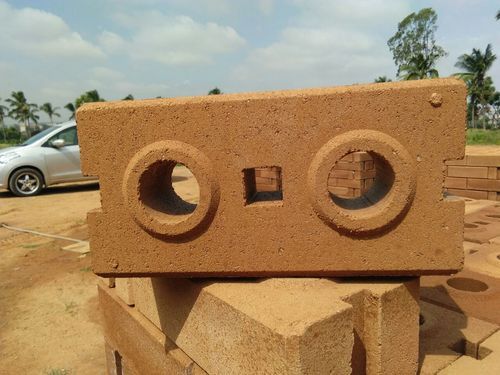

A compressed earth block (CEB), also known as a pressed earth block or a compressed soil block, is a building material made primarily from damp soil compressed at high pressure to form blocks. Compressed earth blocks use a mechanical press to form blocks out of an appropriate mix of fairly dry inorganic subsoil, non-expansive clay and aggregate. If the blocks are stabilized with a chemical binder such as Portland cement they are called compressed stabilized earth block (CSEB) or stabilized earth block (SEB). Typically, around 3,000 psi (21 MPa) is applied in compression, and the original soil volume is reduced by about half.
CEBs are assembled onto walls using standard bricklaying and masonry techniques. The mortar may be a simple slurry made of the same soil/clay mix without aggregate, spread or brushed very thinly between the blocks for bonding, or cement mortar may also be used for high strength, or when construction during freeze-thaw cycles causes stability issues. Hydraform blocks are shaped to be interlocking. The compression strength of properly made CEB can meet or exceed that of typical cement or mud brick. Building standards have been developed for CEB.
There are many advantages of the CEB system. On-site materials can be used, which reduces cost, minimizes shipping costs for materials, and increases efficiency and sustainability. The wait-time required to obtain materials is minimal, because after the blocks are pressed, materials are available very soon after a short drying period. The uniformity of the blocks simplifies construction, and minimizes or eliminates the need for mortar, thus reducing both the labor and materials costs. The blocks are strong, stable, water-resistant and long-lasting.
Completed walls require either a reinforced bond beam or a ring beam on top or between floors and if the blocks are not stabilized, a plaster finish, usually stucco wire/stucco cement and/or lime plaster. Stabilized blocks can be left exposed with no outer plaster finish. In tropical environments, polycarbonate varnish is often used to provide an additional layer of wet-weather protection. This also provides the contractor the option of making the exteriors look like conventional stucco houses.